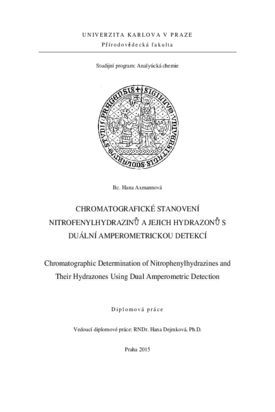Chromatografické stanovení nitrofenylhydrazinů a jejich hydrazonů s duální amperometrickou detekcí
Chromatographic determination of nitrophenylhydrazines and their hydrazones using dual amperometric detection
diploma thesis (DEFENDED)

View/
Permanent link
http://hdl.handle.net/20.500.11956/84135Identifiers
Study Information System: 143410
CU Caralogue: 990020276330106986
Collections
- Kvalifikační práce [20861]
Author
Advisor
Referee
Fischer, Jan
Faculty / Institute
Faculty of Science
Discipline
Analytical Chemistry
Department
Department of Analytical Chemistry
Date of defense
8. 9. 2015
Publisher
Univerzita Karlova, Přírodovědecká fakultaLanguage
Czech
Grade
Very good
V této diplomové práci bylo optimalizováno stanovení nitrofenylhydrazinů pomocí vysokoúčinné kapalinové chromatografie s elektrochemickou detekcí na duální tenkovrstvé elektrodě. K porovnání byla použita spektrofotometrická detekce. Tato metoda byla dále testována ke stanovení hydrazonu vzniklého reakcí 2,4-dinitrofenylhydrazinu (DNPH) s benzaldehydem jako zástupcem látek obsahujících karbonylovou skupinu. Optimalizovanými parametry bylo pH vodné složky mobilní fáze a zejména potenciál vkládaný na pracovní elektrody. Z hydrodynamických voltamogramů bylo vybráno prostředí o pH 3 a pracovní potenciály +1,0 V a -1,0 V. Za těchto podmínek byla zkoumána opakovatelnost měření. Byly také proměřeny koncentrační závislosti, ze kterých byly určeny meze detekce. Mez detekce byla určena z výšky píku jak v anodické, tak v katodické oblasti. Pro 2- nitrofenylhydrazin (2-NPH) byly tyto meze 9,5·10-8 mol/L a 6,2·10-7 mol/L. Pro 2,4- dinitrofenylhydrazin pak 2,1·10-8 mol/L a 1,8·10-7 mol/L. K výrobě hydrazonu byl použit jen DNPH, který měl lepší odezvu v katodické oblasti, a byl smíchán s benzaldehydem. Bylo zkoumáno elektrochemické chování vzniklého benzaldehyd-2,4-dinitrofenylhydrazonu v prostředí o pH 3. Z hydrodynamického voltamogramu byl vybrán pracovní potenciál -1,0 V. Dále byla zkoumána kvantitativnost...
This diploma thesis examines the optimization of the determination of nitrophenylhydrazines using high performance liquid chromatography with electrochemical detection on dual thin-layer electrode. The spectrophotometric detection was used for the comparison. The developed method was also tested for the determination of hydrazone produced by the reaction of 2,4-dinitrophenylhydrazine (DNPH) with benzaldehyde as a member of substances containing carbonyl group. The conditions for the determination of nitrophenylhydrazines were optimized; based on the hydrodynamic voltammograms, pH 3 of aqueous part of the mobile phase and potentials of +1,0 V and -1,0 V were chosen. Under these conditions, the repeatability was tested. The concentration dependences were also measured and detection limits were obtained. The detection limits were obtained from the peak heights both in anodic and cathodic potential range. For 2-nitrophenylhydrazine these limits were 9,5·10-8 mol/L for oxidation and 6,2·10-7 mol/L for reduction. For 2,4-dinitrophenylhydrazine the limits were 2,1·10-8 mol/L and 1,8·10-7 mol/L for oxidation and for reduction, respectively. For the preparation of hydrazone, DNPH was chosen due to its better cathodic response and it was mixed with benzaldehyde. The electrochemical behaviour of...
